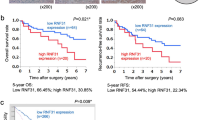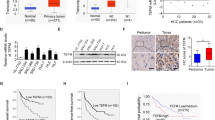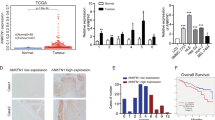Abstract
Background
Perturbations in the nuclear microenvironment, including transport systems, play a critical role in malignant progression, but the nuclear import abnormalities remain unclear in hepatocarcinogenesis. We analyzed the role of importin in hepatocellular carcinoma (HCC).
Methods
Gene expression profiling of the importin family was performed in HCC tissues. The significance of importin protein expression was analyzed in vitro as well as clinicopathologically.
Results
According to the microarray profiles, the importin-α1 was dominantly overexpressed in HCC tissues as compared to the adjacent noncancerous tissues. By means of human HCC cell lines, a knockdown of importin-α1 by its siRNA greatly reduced cellular proliferation by 15.2–26.6% (P < 0.005). Immunohistochemical analysis on tissue samples demonstrated cancer-specific overexpression in 36.3% of HCCs. The overexpression of importin-α1 was correlated statistically with high levels of alfa-fetoprotein (P = 0.0017), the tumor number (P = 0.0116), histological dedifferentiation (P = 0.0054), tumor morphology (P = 0.0433), portal vein invasion (P = 0.0007), hepatic vein invasion (P = 0.0081), Fc (P = 0.0367), Fc-inf (P = 0.0122), and the tumor, node, metastasis stage (P = 0.0026); this resulted in a significantly poorer prognosis in both overall survival (P = 0.0164) and recurrence-free survival (P = 0.0101). Multivariate analysis of recurrence-free survival revealed importin-α1 expression to be a statistically significant factor (P = 0.0361). In addition, early recurrence after curative resection was observed more frequently in the importin-α1-positive group as compared to the negative group (P = 0.0023). The multivariate analysis identified importin-α1 as the only independent predictor of early recurrence after HCC resection (odds ratio = 5.291, P = 0.0191).
Conclusions
Because importin-α1 might be closely associated with HCC progression, further analysis should be pursued to evaluate it as a novel prognostic target.


Similar content being viewed by others
References
Poon RT, Fan ST, Wong J. Risk factors, prevention, and management of postoperative recurrence after resection of hepatocellular carcinoma. Ann Surg. 2000;232:10–24.
Shimada M, Takenaka K, Gion T, et al. Prognosis of recurrent hepatocellular carcinoma: a 10-year surgical experience in Japan. Gastroenterology. 1996;111:720–6.
Poon RT, Fan ST, Lo CM, Liu CL, Wong J. Intrahepatic recurrence after curative resection of hepatocellular carcinoma: long-term results of treatment and prognostic factors. Ann Surg. 1999;229:216–22.
Arii S, Yamaoka Y, Futagawa S, et al. Results of surgical and nonsurgical treatment for small-sized hepatocellular carcinomas: a retrospective and nationwide survey in Japan. The Liver Cancer Study Group of Japan. Hepatology. 2000;32:1224–9.
Llovet JM, Bruix J. Molecular targeted therapies in hepatocellular carcinoma. Hepatology. 2008;48:1312–27.
Zaidi SK, Young DW, Javed A, et al. Nuclear microenvironments in biological control and cancer. Nat Rev Cancer. 2007;7:454–63.
Chahine MN, Pierce GN. Therapeutic targeting of nuclear protein import in pathological cell conditions. Pharmacol Rev. 2009;61:358–72.
Kutay U, Mühlhäusser P. Cell biology: taking a turn into the nucleus. Nature. 2006;442:991–2.
Görlich D, Kutay U. Transport between the cell nucleus and the cytoplasm. Annu Rev Cell Dev Biol. 1999;15:607–60.
Johnson HM, Subramaniam PS, Olsnes S, Jans DA. Trafficking and signaling pathways of nuclear localizing protein ligands and their receptors. Bioessays. 2004;26:993–1004.
Kaffman A, O’Shea EK. Regulation of nuclear localization: a key to a door. Annu Rev Cell Dev Biol. 1999;15:291–339.
Cyert MS. Regulation of nuclear localization during signaling. J Biol Chem. 2001;276:20805–8.
Fukasawa K. Oncogenes and tumour suppressors take on centrosomes. Nat Rev Cancer. 2007;7:911–24.
Pascale RM, Simile MM, Calvisi DF, et al. Role of HSP90, CDC37, and CRM1 as modulators of P16(INK4A) activity in rat liver carcinogenesis and human liver cancer. Hepatology. 2005;42:1310–9.
Quackenbush J. Microarray analysis and tumor classification. N Engl J Med. 2006;354:2463–72.
Hoshida Y, Villanueva A, Kobayashi M, et al. Gene expression in fixed tissues and outcome in hepatocellular carcinoma. N Engl J Med. 2008;359:1995–2004.
Tanaka S, Arii S, Yasen M, et al. Aurora kinase B is a predictive factor for the aggressive recurrence of hepatocellular carcinoma after curative hepatectomy. Br J Surg. 2008;95:611–9.
Park JH, Koh KC, Choi MS, et al. Analysis of risk factors associated with early multinodular recurrences after hepatic resection for hepatocellular carcinoma. Am J Surg. 2006;192:29–33.
Yokoo H, Kondo T, Okano T, et al. Protein expression associated with early intrahepatic recurrence of hepatocellular carcinoma after curative surgery. Cancer Sci. 2007;98:665–73.
Lu X, Zhao H, Yang H, et al. A prospective clinical study on early recurrence of hepatocellular carcinoma after hepatectomy. J Surg Oncol. 2009;100:488–93.
Tanaka S, Pero SC, Taguchi K, et al. Specific peptide ligand for Grb7 signal transduction protein and pancreatic cancer metastasis. J Natl Cancer Inst. 2006;98:491–8.
Bressac B, Galvin KM, Liang TJ, Isselbacher KJ, Wands JR, Ozturk M. Abnormal structure and expression of p53 gene in human hepatocellular carcinoma. Proc Natl Acad Sci USA. 1990;87:1973–7.
Komlodi-Pasztor E, Trostel S, Sackett D, Poruchynsky M, Fojo T. Impaired p53 binding to importin: a novel mechanism of cytoplasmic sequestration identified in oxaliplatin-resistant cells. Oncogene. 2009;28:3111–20.
Marchenko ND, Hanel W, Li D, Becker K, Reich N, Moll UM. Stress-mediated nuclear stabilization of p53 is regulated by ubiquitination and importin-alpha3 binding. Cell Death Differ. 2010;17:255–67.
Chook YM, Blobel G. Karyopherins and nuclear import. Curr Opin Struct Biol. 2001;11:703–15.
Kau TR, Way JC, Silver PA. Nuclear transport and cancer: from mechanism to intervention. Nat Rev Cancer. 2004;4:106–17.
Dahl E, Kristiansen G, Gottlob K, et al. Molecular profiling of laser-microdissected matched tumor and normal breast tissue identifies karyopherin alpha2 as a potential novel prognostic marker in breast cancer. Clin Cancer Res. 2006;12:3950–60.
Dankof A, Fritzsche FR, Dahl E, et al. KPNA2 protein expression in invasive breast carcinoma and matched peritumoral ductal carcinoma in situ. Virchows Arch. 2007;451:877–81.
Winnepenninckx V, Lazar V, Michiels S, et al. Melanoma Group of the European Organization for Research and Treatment of Cancer. Gene expression profiling of primary cutaneous melanoma and clinical outcome. J Natl Cancer Inst. 2006;98:472–82.
Gluz O, Wild P, Meiler R, et al. Nuclear karyopherin alpha2 expression predicts poor survival in patients with advanced breast cancer irrespective of treatment intensity. Int J Cancer. 2008;123:1433–8.
Stein GS, Davie JR, Knowlton JR, Zaidi SK. Nuclear microenvironments and cancer. J Cell Biochem. 2008;104:1949–52.
Tanaka S, Arii S. Molecularly targeted therapy for hepatocellular carcinoma. Cancer Sci. 2009;100:1–8.
Fornerod M, Ohno M, Yoshida M, Mattaj IW. CRM1 is an export receptor for leucine-rich nuclear export signals. Cell. 1997;90:1051–60.
Kudo N, Matsumori N, Taoka H, et al. Leptomycin B inactivates CRM1/exportin 1 by covalent modification at a cysteine residue in the central conserved region. Proc Natl Acad Sci USA. 1999;96:9112–7.
Mutka SC, Yang WQ, Dong SD, et al. Identification of nuclear export inhibitors with potent anticancer activity in vivo. Cancer Res. 2009;69:510–7.
Newlands ES, Rustin GJ, Brampton MH. Phase I trial of elactocin. Br J Cancer. 1996;74:648–9.
Vigneri P, Wang JY. Induction of apoptosis in chronic myelogenous leukemia cells through nuclear entrapment of BCR-ABL tyrosine kinase. Nat Med. 2001;7:228–34.
Aloisi A, Di Gregorio S, Stagno F, et al. BCR-ABL nuclear entrapment kills human CML cells: ex vivo study on 35 patients with the combination of imatinib mesylate and leptomycin B. Blood. 2006;107:1591–8.
Kosugi S, Hasebe M, Entani T, Takayama S, Tomita M, Yanagawa H. Design of peptide inhibitors for the importin alpha/beta nuclear import pathway by activity-based profiling. Chem Biol. 2008;15:940–9.
Acknowledgment
This work was supported by a Grant-in Aid for Scientific Research and Health Labor Sciences Research Grant, Japan. We thank Ayumi Shioya for her technical assistance.
Author information
Authors and Affiliations
Corresponding author
Electronic supplementary material
Below is the link to the electronic supplementary material.
Rights and permissions
About this article
Cite this article
Yoshitake, K., Tanaka, S., Mogushi, K. et al. Importin-α1 as a Novel Prognostic Target for Hepatocellular Carcinoma. Ann Surg Oncol 18, 2093–2103 (2011). https://doi.org/10.1245/s10434-011-1569-7
Received:
Published:
Issue Date:
DOI: https://doi.org/10.1245/s10434-011-1569-7




